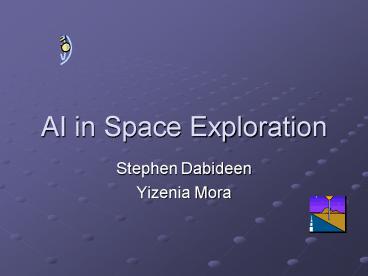AI in Space Exploration - PowerPoint PPT Presentation
1 / 14
Title: AI in Space Exploration
1
AI in Space Exploration
- Stephen Dabideen
- Yizenia Mora
2
Agenda
- Planning and Scheduling (CASPER)
- Autonomous Navigation (AutoNav)
- Communications with Earth (Beacon)
- Autonomous Onboard Science (ASE OASIS)
- Data Mining (SKICAT)
3
Autonomous Navigation (AutoNav)
- What is AutoNav?
- Autonomous Optical Navigation system uses an
expert-system-like architecture to guide a
spacecraft to its target, first used in DS1 - Enables a spacecraft to navigate independently of
ground teams and ground links - It commands the ion propulsion system and the
spacecraft's altitude control system to change
trajectory as needed - AutoNav also determines how much power to devote
to the ion propulsion system - Use location to determine how much energy
generated by solar array - Intended to be reusable
4
Autonomous Navigation (AutoNav)
- Subsystems functions
- Navigation executive function
- Controls all AutoNav operations that cause
physical action by spacecraft. - Optimizes time utilization by planning turn
sequences - Image processing
- Integrates camera and imaging spectrometer to
take pictures of asteroids and stars, to
determine its location - 0.1 pixel accuracy
- Orbit determination
- Uses a batch-sequential modified Kalman filter to
compute the spacecrafts position - Maneuver planning
- Use OD to compute updates to upcoming trust plan.
5
Communications with Earth (Beacon)
- Spacecraft determines when ground support is
needed and what information is relevant - Advantages
- Reduces costs of the spacecraft-to-ground link
- Downlinks only pertinent information
6
Communications with Earth (Beacon)
- Two subsystems
- Subsystem 1
- End-to-end tone system to inform the ground
whether data needs to be sent - One of four possible requests (no action
required, contact when convenient, contact within
a certain time, or contact immediately) - Subsystem 2
- Produce intelligent data summaries to be
downlinked as telemetry when ground responds to
tone request - Four types of engineering telemetry
- High-level spacecraft information since the last
ground contact - Episode data
- Snapshot telemetry
- Performance data
- ELMER used to detect anomalies
7
Communications with Earth (Beacon)Detecting
Anomalies (ELMER)
- Traditional thresholds
- Static, manually predefined red lines
- A lot of false alarms
- ELMER (Envelope Learning and Monitoring using
Error Relaxation) - Time-varying alarm thresholds
- Neural networks
- Trained with nominal sensor data
- High- and low-expectation bounds (envelopes)
8
Autonomous On-Board Science
- The dream
- An autonomous Mars rover traversing the planets
surface for a couple of years, unattended by
humans, collecting and catching samples
9
Autonomous On-Board Science
- The dream
- An autonomous Mars rover traversing the planets
surface for a couple of years, unattended by
humans, collecting and catching samples - Reality check Spirit and Opportunity
- 4 drivers per rover
- About 20 simulations per move
- Remote-controlled over 150 million miles away
- Opportunity's farthest distance to date 15 m
10
Autonomous On-Board Science
- Need for automated science
- Slim window of opportunity for discovery
- Autonomy can provide more reactive, flexible
architecture to respond to unanticipated events - Limited downlink bandwidth
- Time delay
- Accomplishments thus far
- New method analyzing visible broadband images
using neural networks - Important features extracted and combined with
spectral classifications and decisions are made
using a decision tree directed towards specific
goals - Analysis of spectral data
- Hierarchy of neural nets place spectra into
progressively more detailed geologic classes - Decompose mixtures from unknown spectra
- Will help automate characterization of planetary
surface
11
Autonomous On-Board Science (ASE)
- The Autonomous Sciencecraft Experiment (ASE)
- Used on Earth Observing One (EO -1)
- Demonstrates integrated autonomous science
- Features several science algorithms including
- Event detection
- Feature detection
- Change detection
- Analyzes to detect trigger conditions such as
science events - Based on these observations CASPER will replan
- Science analysis techniques include
- Thermal anomaly detection
- Cloud detection
- Flood scene classification
12
Autonomous On-Board Science (OASIS)
- Onboard Autonomous Science investigation System
- Due to limited bandwidth, rovers must
intelligently select what data to transmit
back to Earth - How?
- Machine leaning techniques to prioritize data
- The capability of OASIS enables a rover to
perform data collections which were not
originally planned, even without having to wait
for a command from Earth - Researchers are interested in
- Pre-specified signals of scientific interest
- Unexpected or anomalous features
- Typical characteristics of a region
- OASIS has different levels of autonomy, from
following a predefined path and taking only
planned measurements to commanding the rover to
deviate slightly from path to get new measurements
13
Data Mining (SKICAT)
- What?
- SKy-Image Cataloging and Analysis Tool
- Assign galaxies and stars to known classes and
identify new classes - Why?
- Databases are too large for an astronomer to
analyze manually - How?
- Automated Bayesian classification
- Attributes such as brightness, area, color,
morphology, - Training data consisting of astronomer-classified
sky objects - Classifiers applied to new survey images
14
Data Mining (SKICAT)
- Results
- One of the most outstanding successes
- 1,000-10,000 times faster than astronomers
- More consistent classification
- Able to classify extremely faint objects
- Astronomers freed for more challenging analysis
and interpretation - Comprehensive catalog of approximately 3 billion
entries































